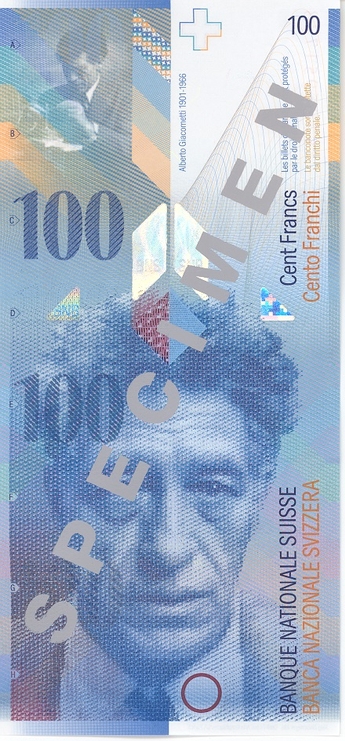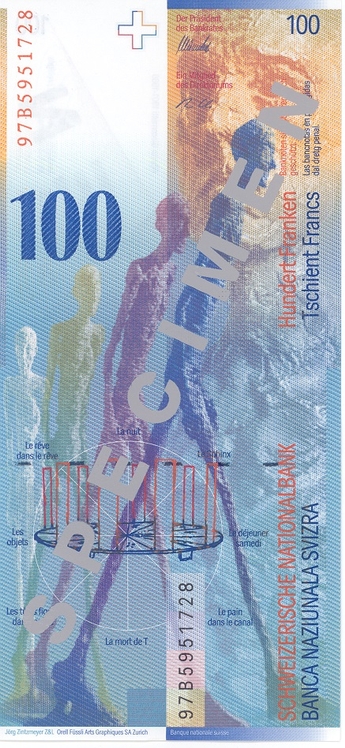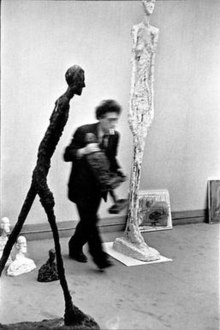Alberto Giacometti
From Wikipedia, the free encyclopedia
| Alberto Giacometti | |
|---|---|
Portrait of A. Giacometti by Jan Hladík, 2002, etching
|
|
| Born | 10 October 1901 Borgonovo, Stampa, Graubünden, Switzerland |
| Died | 11 January 1966 (aged 64) Chur, Graubünden, Switzerland |
| Nationality | Swiss |
| Field | Sculpture, Painting, Drawing |
| Training | The School of Fine Arts, Geneva |
| Movement | Surrealism, Expressionism, Cubism, Formalism |
| Awards | "Grand Prize for Sculpture" at 1962 Venice Biennale |
Contents
Early life
In 1922 he moved to Paris to study under the sculptor Antoine Bourdelle, an associate of Auguste Rodin. It was there that Giacometti experimented with cubism and surrealism and came to be regarded as one of the leading surrealist sculptors. Among his associates were Joan Miró, Max Ernst, Pablo Picasso, Bror Hjorth and Balthus.
Between 1936 and 1940, Giacometti concentrated his sculpting on the human head, focusing on the sitter's gaze. He preferred models he was close to, his sister and the artist Isabel Rawsthorne (then known as Isabel Delmer). This was followed by a unique artistic phase in which his statues of Isabel became stretched out; her limbs elongated.[1] Obsessed with creating his sculptures exactly as he envisaged through his unique view of reality, he often carved until they were as thin as nails and reduced to the size of a pack of cigarettes, much to his consternation. A friend of his once said that if Giacometti decided to sculpt you, "he would make your head look like the blade of a knife." After his marriage to Annette Arm in 1946 his tiny sculptures became larger, but the larger they grew, the thinner they became. Giacometti said that the final result represented the sensation he felt when he looked at a woman.
His paintings underwent a parallel procedure. The figures appear isolated, are severely attenuated, and are the result of continuous reworking. Subjects were frequently revisited: one of his favorite models was his younger brother Diego Giacometti.[2] A third brother, Bruno Giacometti, was a noted architect.
Later years
In 1962, Giacometti was awarded the grand prize for sculpture at the Venice Biennale, and the award brought with it worldwide fame. Even when he had achieved popularity and his work was in demand, he still reworked models, often destroying them or setting them aside to be returned to years later. The prints produced by Giacometti are often overlooked but the catalogue raisonné, Giacometti - The Complete Graphics and 15 Drawings by Herbert Lust (Tudor 1970), comments on their impact and gives details of the number of copies of each print. Some of his most important images were in editions of only 30 and many were described as rare in 1970.
In his later years Giacometti's works were shown in a number of large exhibitions throughout Europe. Riding a wave of international popularity, and despite his declining health, he travelled to the United States in 1965 for an exhibition of his works at the Museum of Modern Art in New York. As his last work he prepared the text for the book Paris sans fin, a sequence of 150 lithographs containing memories of all the places where he had lived.
Giacometti died in 1966 of heart disease (pericarditis) and chronic bronchitis at the Kantonsspital in Chur, Switzerland. His body was returned to his birthplace in Borgonovo, where he was interred close to his parents. In May 2007 the executor of his widow's estate, French foreign minister Roland Dumas, was convicted of illegally selling Giacometti's works to a top auctioneer. The auctioneer, Jacques Tajan, was also convicted. Both were ordered to pay €850,000 to the Alberto and Annette Giacometti Foundation.[5]
Artistic analysis
Giacometti was a key player in the Surrealist art movement, but his work resists easy categorization. Some describe it as formalist, others argue it is expressionist or otherwise having to do with what Deleuze calls 'blocs of sensation' (as in Deleuze's analysis of Francis Bacon). Even after his excommunication from the Surrealist group, while the intention of his sculpting was usually imitation, the end products were an expression of his emotional response to the subject. He attempted to create renditions of his models the way he saw them, and the way he thought they ought to be seen. He once said that he was sculpting not the human figure but "the shadow that is cast."Scholar William Barrett in Irrational Man: A Study in Existential Philosophy (1962), argues that the attenuated forms of Giacometti's figures reflect the view of 20th century modernism and existentialism that modern life is increasingly empty and devoid of meaning. "All the sculptures of today, like those of the past, will end one day in pieces... So it is important to fashion ones work carefully in its smallest recess and charge every particle of matter with life."
A new exhibition in Paris, since September 2011, shows how Giacometti strongly drew his inspiration for his work from Etruscan art.[6]
Legacy
Exhibitions
Giacometti's work has been the subject of numerous solo exhibitions including most recently Pushkin Museum, Moscow (2008); “The Studio of Alberto Giacometti: Collection of the Fondation Alberto et Annette Giacometti,” Centre Pompidou, Paris (2007-2008); Kunsthal Rotterdam (2008); Fondation Beyeler, Basel (2009), Buenos Aires (2012); and Kunsthalle Hamburg (2013).Public collections
Giacometti's work is displayed in numerous public collections, including the:- Albright-Knox Art Gallery, Buffalo
- Art Institute of Chicago
- Baltimore Museum of Art, in Baltimore, Maryland
- Bechtler Museum of Modern Art, in Charlotte, North Carolina
- Berggruen Museum, Berlin
- Bündner Kunstmuseum, in Chur, Switzerland
- Carnegie Museum of Art, in Pittsburgh
- Detroit Institute of Arts
- Hirshhorn Museum and Sculpture Garden, Washington D.C.
- J. Paul Getty Museum, in Los Angeles, California
- Johnson Museum of Art at Cornell University
- Kunsthaus Zürich
- Los Angeles County Museum of Art
- Louisiana Museum of Modern Art, in Denmark
- Museo Botero, in Bogotá, Colombia
- Museum of Modern Art, New York
- Museum of Fine Arts, Boston
- National Gallery of Art in Washington D.C.
- Sainsbury Centre for Visual Arts at University of East Anglia
- Solomon R. Guggenheim Museum, New York
- Tate, London
- Tehran Museum of Contemporary Art, in Iran
- University of Michigan Museum of Art
- Leeum, Samsung Museum of Art, Republic of Korea [7]
Art Foundations
The Fondation Alberto et Annette Giacometti, having received a bequest from Alberto Giacometti's widow Annette, holds a collection of circa 5,000 works, frequently displayed around the world through exhibitions and long-term loans. A public interest institution, the Foundation was created in 2003 and aims at promoting, disseminating, preserving and protecting Alberto Giacometti's work.The Alberto Giacometti-Stiftung established in Zürich in 1965, holds a smaller collection of works acquired from the collections of Pittsburgh industrialist G. David Thompson.
Notable sales
In November 2000 a Giacometti bronze, Grande Femme Debout I, sold for $14.3 million.[8] Grande Femme Debout II was bought by the Gagosian Gallery for $27.4 million at Christie's auction in New York City on May 6, 2008.[9]L'Homme qui marche I, a life-sized bronze sculpture of a man, became one of the most expensive works of art and the most expensive sculpture ever sold at auction on February 2, 2010 when it sold for £65 million (US$104.3 million) at Sotheby's, London.[10][11] Grande tête mince, a large bronze bust, sold for $53.3 million just three months later.
Other legacy
Giacometti created the monument on the grave of Gerda Taro at Père Lachaise Cemetery.[12]In 2001 he was included in the Painting the Century 101 Portrait Masterpieces 1900-2000 exhibition held at the National Portrait Gallery, London.
Giacometti and his sculpture L'Homme qui marche I appear on the current 100 Swiss Franc banknote.[13]
According to Dr. Michael Peppiatt in a lecture at Cambridge University on July 8, 2010, Giacometti, who had a friendship with author/playwright Samuel Beckett, created a tree for the set of a 1961 Paris production of "Waiting For Godot".
Notes
- Jump up ^ New York Times article on The Women of Giacometti exhibition, Pace Wildenstein Gallery 2005 [1]
- Jump up ^ Tate Collection: Seated Man by Alberto Giacometti Retrieved July 13, 2007.
- Jump up ^ http://www.christies.com/LotFinder/LotDetailsPrintable.aspx?intObjectID=5075599
- Jump up ^ James Lord, Giacometti: A Biography, Farrar, Straus and Giroux, New York, 1986, pp. 331-332 ISBN ISBN 978-0-374-52525-5 ISBN 0374525250
- Jump up ^ "Conviction Upheld Against Former French FM in Giacometti Fraud". May 10, 2007. Retrieved 2008-04-16
- Jump up ^ Giacometti and The Etruscans, La Pinacothèque de Paris
- Jump up ^ http://leeum.samsungfoundation.org/html_eng/exhibition/exhibition_view.asp
- Jump up ^ "Art record Picasso painting goes for £39m at auction". The Guardian (London). 2000-11-10. Retrieved 2010-04-23.
- Jump up ^ Afp.google.com, Monet fetches record price at New York auction
- Jump up ^ http://news.bbc.co.uk/1/hi/uk/8497287.stm Giacometti sculpture fetches £65m at Sotheby's auction
- Jump up ^ Alberto Giacometti's Walking Man I Sells for a Record-Breaking $104,327,006 at Sotheby's
- Jump up ^ Robert Whelan, "Robert Capa, the definitive collection", p8, Phaidon press 2001 ISBN 978-0-7148-4449-7
- Jump up ^ Schweizer Nationalbank
References
- Jacques Dupin (1962) "Alberto Giacometti", Paris, Maeght
- Reinhold Hohl (1971) "Alberto Giacometti", Stuttgart: Gerd Hatje
- Die Sammlung der Alberto Giacometti-Stiftung (1990), Zürich, Zürcher Kunstgesellschaft
- Alberto Giacometti. Sculptures - peintures - dessins. Paris, Musée d'art moderne de la Ville de Paris, 1991-92.
- Jean Soldini (1993) "Alberto Giacometti. Le colossal, la mère, le sacré", Lausanne, L'Age d'Homme
- David Sylvester (1996) Looking at Giacometti, Henry Holt & Co.
- Alberto Giacometti 1901-1966. Kunsthalle Wien, 1996
- James Lord (1997) Giacometti: A Biography, Farrar, Straus and Giroux
- Alberto Giacometti. Kunsthaus Zürich, 2001; New York, The Museum of Modern Art, 2001-2002.
- Yves Bonnefoy (2006) Alberto Giacometti: A Biography of His Work, New edition, Flammarion
- Andreas Weiland, "The Sculptures of Alberto Giacometti / Seen in the Kunsthal Rotterdam (Giacometti Exhibition, October 18, 2008 – February 8, 2009)", in: Art in Society, issue # 10
- Laurie Wilson, (2003) Alberto Giacometti: Myth Magic and the Man (Yale University Press)
Bibliography
- Alberto Giacometti, Yves Bonnefoy, Assouline Publishing (February 22, 2011)
- In Giacometti's Studio, Michael Peppiatt, Yale University Press (December 14, 2010)
- Alberto Giacometti: A Biography of His Work, Yves Bonnefoy, New edition, Flammarion (2006)
- Giacometti: A Biography, James Lord, Farrar, Straus and Giroux (1997)
- Looking at Giacometti, David Sylvester, Henry Holt & Co. (1996)
- Alberto Giacometti, Herbert Matter & Mercedes Matter, Harry N Abrams (September 1987)
- A Giacometti Portrait, James Lord, Farrar, Straus and Giroux (July 1, 1980)
- Alberto Giacometti, Reinhold Hohl, H. N. Abrams (1972)
- Alberto Giacometti, Reinhold Hohl, Stuttgart: Gerd Hatje (1971)
- Alberto Giacometti, Jacques Dupin, Paris, Maeght(1962)
- "The Dream, the Sphinx, and the Death of T", Alberto Giacometti, X magazine, Vol.1, No.1 (November 1959); An Anthology from X (Oxford University Press 1988).
External links
| Wikimedia Commons has media related to Alberto Giacometti. |
- The Alberto et Annette Giacometti Foundation website: [2]
- Alberto Giacometti in the SIKART dictionary and database
- Works of Alberto Giacometti:
- Life of Alberto Giacometti:
- Chronology of his life with illustrations from the Museum of Modern Art
- Exhibition at Kunsthaus Zürich from 27 February until 24 May 2009
- Alberto Giacometti in the National Gallery of Australia's Kenneth Tyler Collection











No comments:
Post a Comment